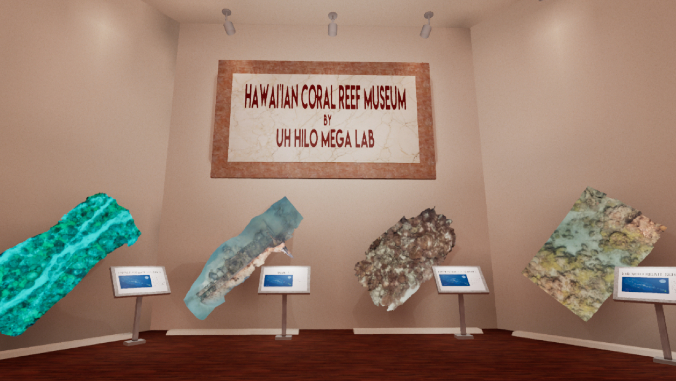A team of undergraduate students from the University of Hawaiʻi at Hilo Department of Computer Science and UH Mānoa College of Engineering were awarded Best Visualization Showcase Award and will be recognized at the upcoming Practice and Experience in Advanced Research Computing 2020 Conference (PEARC20). The team’s project integrated three-dimensional models of Hawaiian coral reefs into an immersive virtual reality platform.
Due to the coronavirus, PEARC20 will be held online on July 26–30 and will explore the current concepts of advanced research computing including modeling, simulation and data-intensive computing.
The UH project, “Exploration of Coral Reefs in Hawaiʻi through Virtual Reality: Hawaiian Coral Reef Museum VR,” showcases models that were generated from high-resolution surveys at long-term monitoring sites throughout the Papahānaumokuākea Marine National Monument. Thousands of images of coral reef habitats were collected by John H.R. Burns, a UH Hilo assistant professor of marine science, and his research team during ship-based research expeditions led by the National Oceanic and Atmospheric Association.
The images were processed by the UH Hilo Multiscale Environmental Graphical Analysis (MEGA) Lab—a lab Burns developed—using structure-from-motion photogrammetry technology to create high-resolution 3D reconstructions of each coral reef study plot.
“The VR application is an incredible way to engage broad audiences and provide them with a unique immersive experience to see coral reefs first hand and witness changes occurring in these valuable ecosystems,” said Burns.
Francis Cristobal, a faculty specialist in the UH Hilo computer science department, spearheaded the two-year project.
“One of the primary objectives was to create virtual outreach products to showcase these incredible and unique products to public audiences around the globe,” Cristobal said. “When the application starts, the user is brought into a Coral Reef Museum filled with a curated selection of coral reefs. The user then picks a reef to explore and is transported to a life-sized 3D model of it. From there, the user can resize, reposition or fly through a 3D model, offering a wide range of interactivity. This human-centered design is particularly an effective platform for researchers, instructors and the general public.”
These reconstructions also allow researchers to examine how the coral reefs change over time and respond to stressors associated with climate change.
Team members:
- John H.R. Burns, UH Hilo Marine Science and MEGA
- Francis Cristobal, UH Hilo Computer Science
- Michael Dodge II, UH Mānoa, Pre-Engineering
- Alec Goodson, UH Hilo Computer Science (graduated spring 2020)
- Drew Gotshalk, UH Hilo Computer Science (graduated spring 2020)
- Jared McLean, UH CyberInfrastructure
- Briana Noll, UH Hilo Computer Science (graduated spring 2020)
- Kailey Pascoe, UH Hilo MEGA lab
- Nickolas Rosenberg, UH Hilo Computer Science (graduated spring 2020)
- Alexandra Runyan, UH Hilo Marine Science
- Joseph Sanchez, UH Hilo Edwin Mookini Library
- Ryan Theriot, UH Mānoa Laboratory for Advanced Visualization and Application
“This was an exciting project to work on,” said Michael Dodge, a UH Hilo alumnus and pre-engineering student at UH Mānoa. “I learned a lot about what goes into VR application development, and doing this as a real-world program for the public made it every bit more interesting.”
The project was funded by the UH Academy for Creative Media System. The virtual museum will be showcased at the Mokupāpapa Discovery Center in Hilo and will be a traveling exhibit. It will also be presented at the Hawaiʻi State Legislature.
For more go to UH Hilo Stories.
—By Susan Enright


